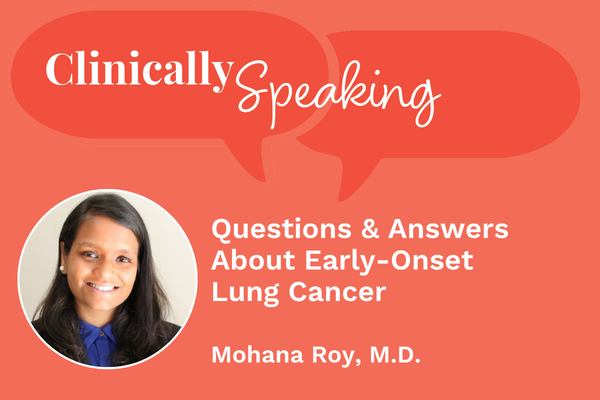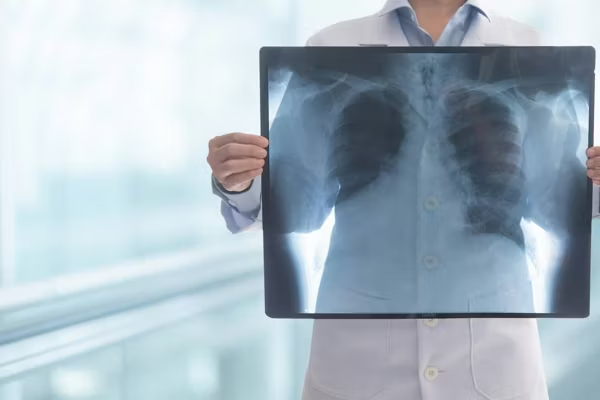Lung cancer is the second most common form of cancer. But over the last 20 years, the rates of lung cancer have gone down for men, but they have been on the rise for women. And that includes women who’ve never smoked.
In fact, lung cancer kills 171 women a day — more than any other form of cancer.
Smoking cigarettes is the leading risk factor for lung cancer. And women who smoke are more likely to develop lung cancer than men who smoke. But, did you know that 2 out of 10 lung cancer cases are diagnosed in people who do not smoke? In fact, almost 1 in 4 women with lung cancer don’t smoke.
Learn more about the symptoms of lung cancer and who to see if you’re concerned about your risks.
What causes lung cancer?
Lung cancer is caused by cancerous cells growing in the lungs. Cancer occurs when old or abnormal cells in the body do not die off as they should, but multiply instead. When cancerous cells grow and multiply, they form a mass — called a tumor — which can take over and destroy normal, healthy tissue.
What are the types of lung cancer?
There are two types of lung cancer: small cell lung cancer (SCLC) and non-small cell lung cancer (NSCLC). NSCLC makes up about 85 out of 100 cases of lung cancer and SCLC makes up the other 15 cases.
SCLC is aggressive and fast-moving. By the time it’s diagnosed, it has likely spread to other areas. NSCLC is less aggressive. But, it’s usually discovered at a later stage. In fact, only about 1 in 4 people with NSCLC are diagnosed at the early stages (stage 1 or stage 2). In 4 out of 10 cases of NSCLC, the cancer has usually spread to other parts of the body by the time it’s diagnosed.
What are the risk factors for lung cancer?
Smoking is the number one cause of lung cancer, but people who don’t smoke can get lung cancer, too. Risk factors for lung cancer include:
- Breathing in toxic substances such as cigarette smoke, radon, asbestos, air pollution and diesel exhaust, and workplace chemicals such as arsenic and vinyl chloride
- Exposure to radioactive minerals, such as uranium
- Drinking arsenic-tainted water
- Previous radiation therapy to the lungs
- Family history of lung cancer
What are the signs and symptoms of lung cancer?
Symptoms of lung cancer can be different depending on the type, location in the lungs and whether the cancer has spread. It’s possible to have no symptoms of lung cancer in the early stages.The early signs of lung cancer can also be similar to upper respiratory infections such as the common cold. However, non-cancerous infections tend to clear up within a week or two.
The most common symptoms of lung cancer include:
- A cough that does not go away, changes or gets worse
- Coughing up blood or spit with blood in it
- Chest pain when breathing deeply, coughing or laughing
- A hoarse voice
- Loss of appetite and/or weight
- Shortness of breath
- Weakness and fatigue
- Recurring infections such as pneumonia or bronchitis
- Wheezing
Lung cancer can spread to the lymph nodes, brain, bones, adrenal glands, liver and other organs, which can lead to additional symptoms.
Who should you see if you have symptoms?
If you’re having symptoms of lung cancer, reach out to your primary care provider (PCP) who will ask you about your medical history and risk factors, such as smoking. Your responses and physical exam results will determine whether you need more tests, such as a chest X-ray or bone scan.
Who makes up the care team for lung cancer?
If you have lung cancer, there will be many specialists that make up your care team who work together to manage your treatment plan. These may include:
- Medical oncologist — creates overall treatment plan for chemotherapy and other medical treatments
- Radiation oncologist — provides radiation therapy
- Thoracic surgeon – operates on organs in the chest, including the lungs
- Interventional pulmonologist — helps diagnose and stage lung cancer and provides treatments
- Pathologist — studies body tissues and body fluids and makes a diagnosis of the specific tumor type
- Radiologist — interprets X-rays, CT and PET scans, and MRIs
- Rehabilitation specialist — teaches people about their condition and helps them cope with symptoms to improve their quality of life
- Palliative care team — helps manage pain and improve quality of life
- Mental health practitioners (psychiatrists, psychologists, social workers) — provide support for mental and emotional well-being
- Clergy or spiritual care — provides support and guidance for religious and spiritual concerns
Why are women at higher risk of lung cancer?
Scientists aren’t sure why women are at higher risk for lung cancer than men. There may be something different about how women’s immune systems work or their genes that put them more at risk, even when they’ve never smoked.
Talk to your HCP if you notice changes in your breathing or have any symptoms of lung cancer. It doesn’t matter if you smoke or not — the sooner lung cancer is diagnosed the better.
Resources
This resource was created with support from Merck.
- Surviving Lung Cancer Helped Me Embrace the Connection Between Body and Mind ›
- I Never Smoked and Got Lung Cancer ›
- Lung Cancer Kills an Alarming Number of Women — But There’s Hope ›
- Lung Cancer ›
- Early Screening for Lung Cancer Can Be a Lifesaver - HealthyWomen ›
- Las pruebas tempranas para detectar cáncer de pulmón pueden salvar vidas - HealthyWomen ›
- Non-Smoking Women Can Get Lung Cancer - HealthyWomen ›
- Mujeres que nunca han fumado pueden desarrollar cáncer pulmonar - HealthyWomen ›
- Understanding the Different Types of Lung Cancer - HealthyWomen ›
- Entender los varios tipos de cáncer de pulmón - HealthyWomen ›
- Desigualdades raciales en las examinaciones de cáncer de pulmón - HealthyWomen ›
- Racial Disparities in Lung Cancer Screening - HealthyWomen ›
- Facts About Lung Cancer Treatments - HealthyWomen ›
- Información acerca de los tratamientos de cáncer pulmonar - HealthyWomen ›
- Symptoms of Lung Cancer - HealthyWomen ›
- Los síntomas de cáncer pulmonar - HealthyWomen ›





